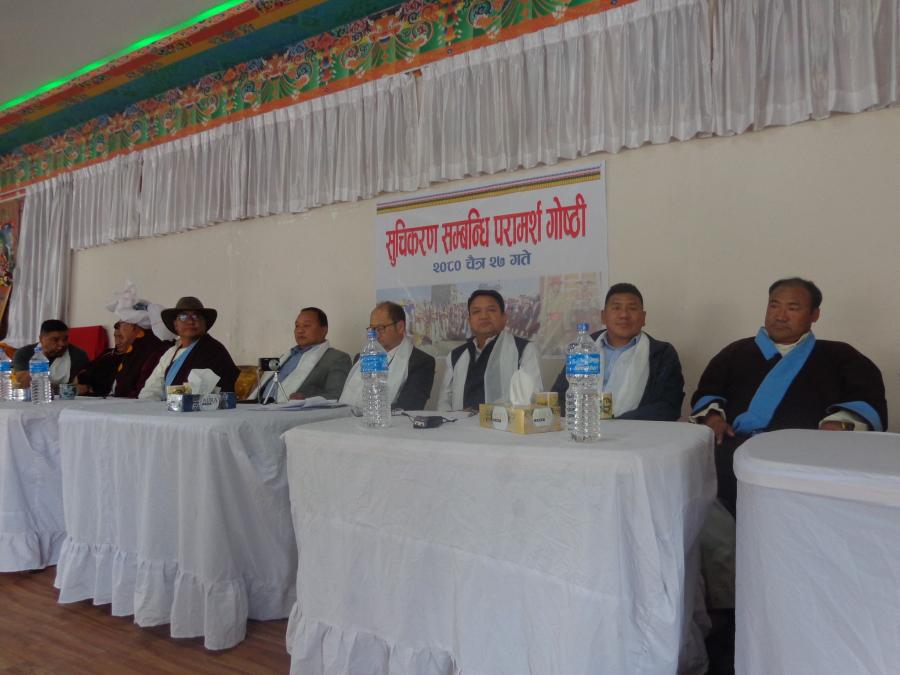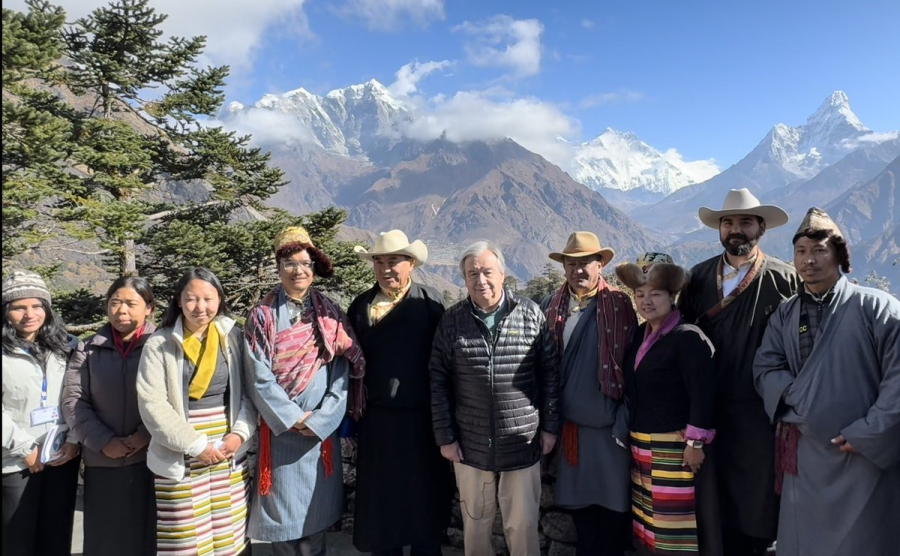Cultural Survival Quarterly: Can you tell us about the path that brought you to the United Nations?
Stella Tamang:
I was born into a small minority within a very small ethnic group in Nepal, but when I married a Tamang, I became a part of that family. Tamang is one of the largest groups of indigenous peoples in Nepal. I come from a family of four sisters and two brothers; my husband has seven brothers and no sisters.We are mountain people. I am the first person from my tribe to get a formal education. When my parents went to Burma to work in a mine as laborers, they took us and we had the opportunity to go to school. I later went to college and studied literature. It was a challenge because I did not speak the mainstream Nepali language.
When I learned English I became aware of how political decisions get made, and that our people were not involved. I also saw how governmental policies and programs were affecting us, and the discrimination that was occurring. The majority of my people were being forced to learn the dominant language and culture, and were not allowed to grow up with their own culture and language. Many people never realize why they are suffering, poor, or mistreated. They take it for granted that that is their way of life.
CSQ: You are a leader in the indigenous rights and the womens rights movements in Nepal. How did you get started in this work?
ST: I felt that unless we recognized that these things were happening to us, our situation was not going to improve. About 1989, the Nepali democracy movement created an environment in which people, especially indigenous people, had a little more freedom to express themselves and organize. Of course indigenous peoples organizations existed before, but they were underground because such organizations were illegal. In 1989 we also got the opportunity to attend international meetings and conferences for indigenous people, and those meetings were empowering. I don't know how much the formal agenda of those conferences helped us, but meeting people outside the meeting rooms and talking and hearing experiences was marvelous.
CSQ: How well does the indigenous rights movement represent the concerns of indigenous women? The indigenous peoples' movement in Nepal, India, and all of South Asia is getting stronger, but it is a male-dominated movement. Women still face a lot of discrimination within indigenous communities and organizations. But the international women's movement does not represent indigenous women. International feminism paints a picture of women's needs that does not reflect the needs of indigenous women. To make matters worse, when we try to participate in women's rights activities, we are accused of weakening the indigenous rights movement.
ST:
To overcome our invisibility, indigenous women started to organize. We began with two organizations. Over time we grew to 13 organizations united under in a federation called the Nepal Women's Federation. Because we are experiencing the same problems as indigenous women in India, Bangladesh, and Sri Lanka, 18 months ago we created the South Asia Indigenous Women's Network.
CSQ: What are the priorities of the South Asia Indigenous Women's Network? We are a new organization and still trying to organize, but we have a few priorities. One is to communicate with indigenous women in their communities so they can better understand how to defend their rights. Many villages do not have electronic media, so we cannot use the computer or the internet. Even paper will not reach many women because the literacy rate is very low. The most effective means of reaching women is to create an oral dissemination program using video cassettes. A second priority is to connect indigenous women with various organizations at the international level. Attending international conferences and having contact with international organizations and peoples is also important.
ST:
CSQ: How are indigenous peoples in Nepal coping with the stresses of the dominant culture? Sometimes I think it is good that our literacy rate is poor, because at least our people are not converted to mainstream culture and mainstream practices. We want to have access to education, but our concern is what kind of education. Do we want education that destroys our culture, our traditions, and our language and our knowledge?
ST:
Education is normally defined by the dominant society, and it often means going to a formal school for 12 years and then going to college to get a degree. But this is not the only kind of education that exists on earth. There is a whole knowledge system that people know and transmit in other way. This education is all about the art of living—how you live happily on this Earth, how we communicate with other human beings, how we communicate and relate with creations of Mother Earth, how we live with the sky and the earth and the universe. If this system is not recognized as education, we are talking about an incomplete education program. Our traditional oral historians are highly educated. But when you try to put them in the Western education box, they get lost. Fortunately, traditional education still takes place in many communities.
Traditional healers also still help our people. They have such a wonderful wealth of knowledge about healing. The problem is there is an enormous effort by the Nepali government and the pharmaceutical companies to convince people that traditional healing is bad. But still, more than fifty percent of the people in Nepal are poor and their health services are provided by a traditional healer. The health service that the government promotes is poor; there are no health posts or hospitals in the remote areas, and if there is a health post, there is no medicine or doctor. There is a shortage of everything. So having a traditional healer makes a big difference. At the same time, traditional healing practices can produce discrimination of another sort. If the traditional healer is a man, he is respected. But if she is a woman, she will be labeled as a witch. Almost every day in the Nepali newspapers you see one or two stories about a woman being stoned or humiliated because she is accused of practicing witchcraft.
CSQ: Your country is enduring a devastating armed conflict. What has been the impact of that conflict on indigenous women? For 80 years, men have either had to join the government army or the Maoist group, or flee their villages to survive. The villages are now populated by mostly women, who are heads of the households. They are not only the feeders, but also the protectors and negotiators. Women are playing a very active role, using all their skills, knowledge, and abilities to protect and save their families. Some of those women are raising their heads and saying "Can we do something?" even though they are sinking in problems. I am interested in developing programs to empower women to lay the foundations for peace-building, because the peace-building does not come down from the top. Everything has to come up from the bottom. Women are contributing to this, but the tragedy is that their contributions are never recognized or documented.
ST:
I am glad that the United Nations recognized us at this year's session of the Permanent Forum on Indigenous Issues, which focused on indigenous women. I am really happy to see the spirit that has come up with the regional meetings and conferences of the South Asia Women's Network. But I hope the spirit will be sustained so that we can follow up at home on all of the work that we do when we meet. Women will have to take a lot of the responsibility to get our problems and contributions recognized.


